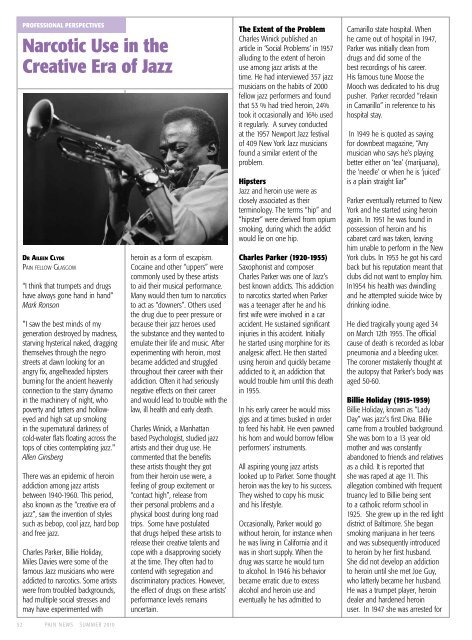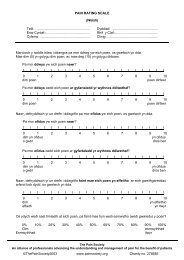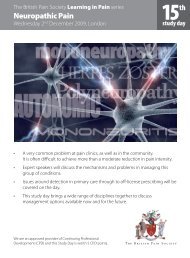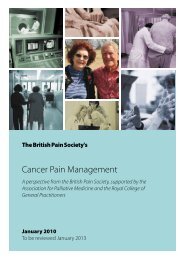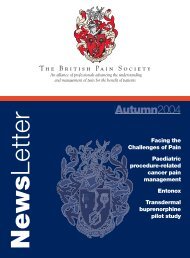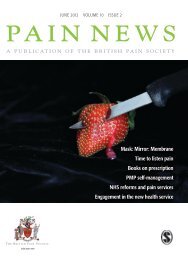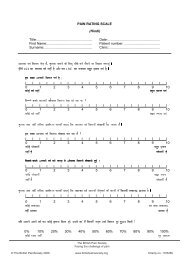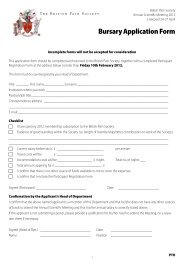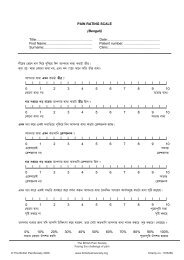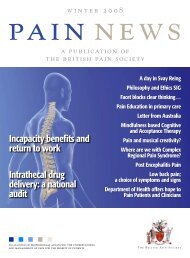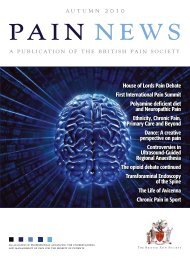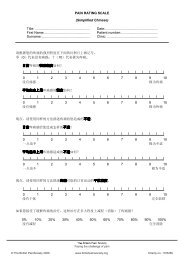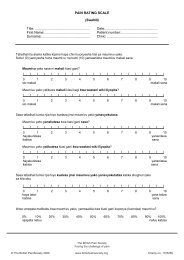Summer 2010 - The British Pain Society
Summer 2010 - The British Pain Society
Summer 2010 - The British Pain Society
You also want an ePaper? Increase the reach of your titles
YUMPU automatically turns print PDFs into web optimized ePapers that Google loves.
PROFESSIONAL PERSPECTIVES<br />
Narcotic Use in the<br />
Creative Era of Jazz<br />
Dr Aileen Clyde<br />
<strong>Pain</strong> fellow Glasgow<br />
“I think that trumpets and drugs<br />
have always gone hand in hand”<br />
Mark Ronson<br />
"I saw the best minds of my<br />
generation destroyed by madness,<br />
starving hysterical naked, dragging<br />
themselves through the negro<br />
streets at dawn looking for an<br />
angry fix, angelheaded hipsters<br />
burning for the ancient heavenly<br />
connection to the starry dynamo<br />
in the machinery of night, who<br />
poverty and tatters and holloweyed<br />
and high sat up smoking<br />
in the supernatural darkness of<br />
cold-water flats floating across the<br />
tops of cities contemplating jazz."<br />
Allen Ginsberg<br />
<strong>The</strong>re was an epidemic of heroin<br />
addiction among jazz artists<br />
between 1940-1960. This period,<br />
also known as the “creative era of<br />
jazz”, saw the invention of styles<br />
such as bebop, cool jazz, hard bop<br />
and free jazz.<br />
Charles Parker, Billie Holiday,<br />
Miles Davies were some of the<br />
famous Jazz musicians who were<br />
addicted to narcotics. Some artists<br />
were from troubled backgrounds,<br />
had multiple social stresses and<br />
may have experimented with<br />
heroin as a form of escapism.<br />
Cocaine and other “uppers” were<br />
commonly used by these artists<br />
to aid their musical performance.<br />
Many would then turn to narcotics<br />
to act as “downers”. Others used<br />
the drug due to peer pressure or<br />
because their jazz heroes used<br />
the substance and they wanted to<br />
emulate their life and music. After<br />
experimenting with heroin, most<br />
became addicted and struggled<br />
throughout their career with their<br />
addiction. Often it had seriously<br />
negative effects on their career<br />
and would lead to trouble with the<br />
law, ill health and early death.<br />
Charles Winick, a Manhattan<br />
based Psychologist, studied jazz<br />
artists and their drug use. He<br />
commented that the benefits<br />
these artists thought they got<br />
from their heroin use were, a<br />
feeling of group excitement or<br />
“contact high”, release from<br />
their personal problems and a<br />
physical boost during long road<br />
trips. Some have postulated<br />
that drugs helped these artists to<br />
release their creative talents and<br />
cope with a disapproving society<br />
at the time. <strong>The</strong>y often had to<br />
contend with segregation and<br />
discriminatory practices. However,<br />
the effect of drugs on these artists’<br />
performance levels remains<br />
uncertain.<br />
<strong>The</strong> Extent of the Problem<br />
Charles Winick published an<br />
article in ‘Social Problems’ in 1957<br />
alluding to the extent of heroin<br />
use among jazz artists at the<br />
time. He had interviewed 357 jazz<br />
musicians on the habits of 2000<br />
fellow jazz performers and found<br />
that 53 % had tried heroin, 24%<br />
took it occasionally and 16% used<br />
it regularly. A survey conducted<br />
at the 1957 Newport Jazz festival<br />
of 409 New York Jazz musicians<br />
found a similar extent of the<br />
problem.<br />
Hipsters<br />
Jazz and heroin use were as<br />
closely associated as their<br />
terminology. <strong>The</strong> terms “hip” and<br />
“hipster” were derived from opium<br />
smoking, during which the addict<br />
would lie on one hip.<br />
Charles Parker (1920-1955)<br />
Saxophonist and composer<br />
Charles Parker was one of Jazz’s<br />
best known addicts. This addiction<br />
to narcotics started when Parker<br />
was a teenager after he and his<br />
first wife were involved in a car<br />
accident. He sustained significant<br />
injuries in this accident. Initially<br />
he started using morphine for its<br />
analgesic affect. He then started<br />
using heroin and quickly became<br />
addicted to it, an addiction that<br />
would trouble him until this death<br />
in 1955.<br />
In his early career he would miss<br />
gigs and at times busked in order<br />
to feed his habit. He even pawned<br />
his horn and would borrow fellow<br />
performers’ instruments.<br />
All aspiring young jazz artists<br />
looked up to Parker. Some thought<br />
heroin was the key to his success.<br />
<strong>The</strong>y wished to copy his music<br />
and his lifestyle.<br />
Occasionally, Parker would go<br />
without heroin, for instance when<br />
he was living in California and it<br />
was in short supply. When the<br />
drug was scarce he would turn<br />
to alcohol. In 1946 his behavior<br />
became erratic due to excess<br />
alcohol and heroin use and<br />
eventually he has admitted to<br />
Camarillo state hospital. When<br />
he came out of hospital in 1947,<br />
Parker was initially clean from<br />
drugs and did some of the<br />
best recordings of his career.<br />
His famous tune Moose the<br />
Mooch was dedicated to his drug<br />
pusher. Parker recorded “relaxin<br />
in Camarillo” in reference to his<br />
hospital stay.<br />
In 1949 he is quoted as saying<br />
for downbeat magazine, “Any<br />
musician who says he’s playing<br />
better either on ‘tea’ (marijuana),<br />
the ‘needle’ or when he is ‘juiced’<br />
is a plain straight liar”<br />
Parker eventually returned to New<br />
York and he started using heroin<br />
again. In 1951 he was found in<br />
possession of heroin and his<br />
cabaret card was taken, leaving<br />
him unable to perform in the New<br />
York clubs. In 1953 he got his card<br />
back but his reputation meant that<br />
clubs did not want to employ him.<br />
In1954 his health was dwindling<br />
and he attempted suicide twice by<br />
drinking iodine.<br />
He died tragically young aged 34<br />
on March 12th 1955. <strong>The</strong> official<br />
cause of death is recorded as lobar<br />
pneumonia and a bleeding ulcer.<br />
<strong>The</strong> coroner mistakenly thought at<br />
the autopsy that Parker’s body was<br />
aged 50-60.<br />
Billie Holiday (1915-1959)<br />
Billie Holiday, known as “Lady<br />
Day” was jazz’s first Diva. Billie<br />
came from a troubled background.<br />
She was born to a 13 year old<br />
mother and was constantly<br />
abandoned to friends and relatives<br />
as a child. It is reported that<br />
she was raped at age 11. This<br />
allegation combined with frequent<br />
truancy led to Billie being sent<br />
to a catholic reform school in<br />
1925. She grew up in the red light<br />
district of Baltimore. She began<br />
smoking marijuana in her teens<br />
and was subsequently introduced<br />
to heroin by her first husband.<br />
She did not develop an addiction<br />
to heroin until she met Joe Guy,<br />
who latterly became her husband.<br />
He was a trumpet player, heroin<br />
dealer and hardened heroin<br />
user. In 1947 she was arrested for<br />
52<br />
PAI N N E W S S U M M E R <strong>2010</strong>


